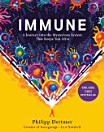Biology of the Arterial Wall
Bernard I. Levy · Alain Tedgui
Nov 2007 · Basic Science for the Cardiologist Book 1 · Springer Science & Business Media
Ebook
278
Pages
reportRatings and reviews aren’t verified Learn More
About this ebook
Biology of the Arterial Wall is intended as a general reference text concerned with the biology of the vascular cells and the blood vessel wall under physiological and pathological conditions. One of the major functions of the arteries is to maintain a continuous blood flow to the organs whatever the pressure conditions, thanks to the vasomotor tone of the smooth muscle cells. Great advances have been made over the last decade in the understanding of the endothelial cells as integrators and transducers of signals originating from the blood stream. The pluripotent control functions of the endothelial cells in the vessel wall are now well recognized. A review of endothelial functions and dysfunctions is presented.
Cell biology and molecular genetic studies have now identified an array of molecules elaborated by endothelial cells and vascular smooth muscle cells and by the blood-borne elements which interact with artery cells, defending the artery against injury and modulating evolving abnormal processes. Molecules which induce or inhibit endothelial and/or smooth muscle cells are currently under great scrutiny. Angiogenesis, which plays a major role in tumor growth, but may also be beneficial as a healing process in muscle ischemia, is discussed.
Apoptosis, or programmed cell death, has only recently been recognized as an essential process in blood vessel modeling and remodeling. An overview of apoptosis in the vascular system is presented.
It is increasingly evident that the adjustments of the blood vessel wall are made in the presence of deforming disease processes such as hypertension and atherosclerosis.
The second part of the book is concerned with the blood vessel wall in disease conditions. Several chapters review the role of the vessel and vascular cells in inflammation, and vascular remodeling during arterial hypertension and aging. One chapter is devoted to atherogenesis, atheroma and plaque instability, followed by the pathophysiology of post-angioplasty restenosis, which is a crucial issue in modern interventional cardiology.
Cell biology and molecular genetic studies have now identified an array of molecules elaborated by endothelial cells and vascular smooth muscle cells and by the blood-borne elements which interact with artery cells, defending the artery against injury and modulating evolving abnormal processes. Molecules which induce or inhibit endothelial and/or smooth muscle cells are currently under great scrutiny. Angiogenesis, which plays a major role in tumor growth, but may also be beneficial as a healing process in muscle ischemia, is discussed.
Apoptosis, or programmed cell death, has only recently been recognized as an essential process in blood vessel modeling and remodeling. An overview of apoptosis in the vascular system is presented.
It is increasingly evident that the adjustments of the blood vessel wall are made in the presence of deforming disease processes such as hypertension and atherosclerosis.
The second part of the book is concerned with the blood vessel wall in disease conditions. Several chapters review the role of the vessel and vascular cells in inflammation, and vascular remodeling during arterial hypertension and aging. One chapter is devoted to atherogenesis, atheroma and plaque instability, followed by the pathophysiology of post-angioplasty restenosis, which is a crucial issue in modern interventional cardiology.
Rate this ebook
Tell us what you think.
Reading information
Smartphones and tablets
Install the Google Play Books app for Android and iPad/iPhone. It syncs automatically with your account and allows you to read online or offline wherever you are.
Laptops and computers
You can listen to audiobooks purchased on Google Play using your computer's web browser.
eReaders and other devices
To read on e-ink devices like Kobo eReaders, you'll need to download a file and transfer it to your device. Follow the detailed Help Center instructions to transfer the files to supported eReaders.








